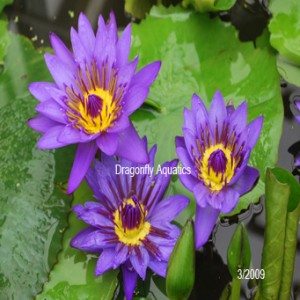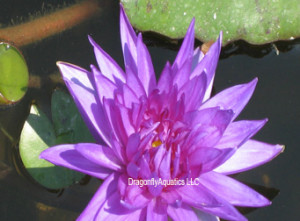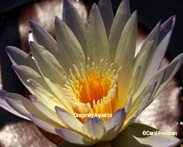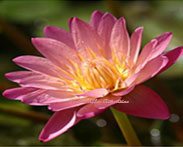 Tropical lilies are usually treated as an annual. They will continue to grow and produce blooms until the temperatures fall below 60 degrees. If you choose to try over-wintering your tropical water lily, moving the potted plant into a greenhouse is the most successful. Another method is to re-pot the lily in a 6” pot and place the lily in at least a 20 gallon or larger aquarium. Keep the water temperature at 70-75 degrees. You will need a fluorescent grow light to provide 10 to 12 hours of artificial sunlight per day. Do not fertilize the lily at this time, as you will not want to encourage any new growth, simply keep the plant alive until temperatures are warm enough in the Spring to move the lily back outside to the pond.
Tropical lilies are usually treated as an annual. They will continue to grow and produce blooms until the temperatures fall below 60 degrees. If you choose to try over-wintering your tropical water lily, moving the potted plant into a greenhouse is the most successful. Another method is to re-pot the lily in a 6” pot and place the lily in at least a 20 gallon or larger aquarium. Keep the water temperature at 70-75 degrees. You will need a fluorescent grow light to provide 10 to 12 hours of artificial sunlight per day. Do not fertilize the lily at this time, as you will not want to encourage any new growth, simply keep the plant alive until temperatures are warm enough in the Spring to move the lily back outside to the pond.
There is one other option for you to try if you are determined to save your tropical lily for next season. Starving the plant in late summer (do not fertilize) will cause the lily to form tubers in the fall. Once the leaves have died off, remove the tuber that has formed under the crown. Wash it thoroughly and air-dry a few days. Remove any roots still attached, wash thoroughly again and place in a jar filled with distilled water or slightly moist sand. Store the container in a cool, dark place at approximately 50 to 60 degrees. Check regularly to make sure the sand is moist, or if storing in water, that the water has not turned foul or discolored. If it has, replace it with fresh distilled water.
See tropical waterlilies,waterlilies here.
 Star of Zanzibar was introduced to water gardening public in 2002. One of my all time favorite tropical day blooming water lilies. Star of Zanzibar has large (5"-6") dark blue flowers with as many as 40 petals per bloom. Heavily variegated leaves with splashes of maroon can reach up to 14" across. This tropical lily is extremely vigorous and blooms heavily throughout the season. The leaves are held close to the center of the plant, making it neat and compact, but it can spread up to six feet across if put in a large plant container. If you would like to grow it in a small to medium pond, plant in a 8" to 12" wide container to limit it's spread to about 4'.
Star of Zanzibar was introduced to water gardening public in 2002. One of my all time favorite tropical day blooming water lilies. Star of Zanzibar has large (5"-6") dark blue flowers with as many as 40 petals per bloom. Heavily variegated leaves with splashes of maroon can reach up to 14" across. This tropical lily is extremely vigorous and blooms heavily throughout the season. The leaves are held close to the center of the plant, making it neat and compact, but it can spread up to six feet across if put in a large plant container. If you would like to grow it in a small to medium pond, plant in a 8" to 12" wide container to limit it's spread to about 4'.
Limited time reduced price Star of Zanzibar here.
 This is one of our favorites! The 'Green Smoke' tropical water lily is an outstanding color of chartreuse with smoky blue tips. Its leaves are lightly speckled, bronze-green and the blooms of the 'Green Smoke' are 6-8 inches held high above the water that are platter shaped.It will spread 5-6 feet on the water surface. This is a good choice for small to medium size ponds.
This is one of our favorites! The 'Green Smoke' tropical water lily is an outstanding color of chartreuse with smoky blue tips. Its leaves are lightly speckled, bronze-green and the blooms of the 'Green Smoke' are 6-8 inches held high above the water that are platter shaped.It will spread 5-6 feet on the water surface. This is a good choice for small to medium size ponds.
You can safely place a tropical waterlily in your outdoor pond when the water reaches a consistent temperature of about 70 degrees. You can stunt the growth or even kill a tropical lily if placed into a cold pond. It sends the lily into shock, returning them to dormancy. You should fertilize the lily every two or three weeks to keep it blooming throughout the warm season.
Purchase Green Smoke, tropical water lily here.
 A popular tropical lily is the 'Albert Greenburg'. Its colors are outstanding and its leaves of mottled colors of burgundy and green bring additional colors to your pond. A tropical lily will tolerate a wide range in soil and water pH, but they do best in a neutral to slightly acidic condition. Tropical lilies thrive in water temperatures in the 80s and will provide you with outstanding colors in your pond throughout the summer.
A popular tropical lily is the 'Albert Greenburg'. Its colors are outstanding and its leaves of mottled colors of burgundy and green bring additional colors to your pond. A tropical lily will tolerate a wide range in soil and water pH, but they do best in a neutral to slightly acidic condition. Tropical lilies thrive in water temperatures in the 80s and will provide you with outstanding colors in your pond throughout the summer.
This lily is a mixure of colors, ranging from pink, yellow and orange with its cup-shaped flowers that will get about 8-9 inches in diameter. The spread of this lily will reach 6-7 feet so its a good lily for medium to larger ponds. This is a good lily for those ponds that only receive some sun as it will bloom and grow with just four hours of sun.
I spent the day taking pictures of planting a tropical lily from our greenhouse to demonstrate how easily this can be done. Start with a nice size pot. I used a 16"x7" small lotus/lily container. The first picture is an example of one of our lilies that you would receive on your order. It's considered a bare root tropical lily.
Planting a tropical lily is different than planting a hardy lily. You want to make sure you get a large container so that the lily can perform at its best. It is recommended that a 2 - 7 gallon pot be used. When you first receive them remove from the plastic bag they arrive in and keep the plant wet and out of the sunlight. Put in a tray of pond water in the shade to re-hydrate it until you can plant it. The soil can be out of your flower or vegetable garden. Heavy soil with some clay base is good. You should stay away from commercial potting soils as they are too light and will float to the top of your pond. Clay kitty litter mixed with some sand will also work, if clay is not available in your area of the country. Inexpensive clay kitty litter ("calcified clay", non-deodorized, making sure it hasn't been chemically treated or deodorized.)
Topical Water Lilies are shipped "bare root" with 3 to 8 leaves and sometimes buds and flowers on them, although these may die back during the transplanting, the lily will immediately start sending up new leaves and buds. Tropical Water lilies should be planted in 2 to 7 gallon pots. A larger container will produce larger and more profuse flowering. Fill the container about half-way with a heavy clay based soil. Scoop out a section in the center of the pot. Place the tuber and roots upright in the center of the pot. Fill and firm the soil around the roots leaving the crown (where the stems and roots connect) level with the soil line keeping the crown exposed. You can then add one fertilizer tablet per gallon of soil, keeping it away from the roots. I like to top it with about an inch of pea gravel or larger size gravel to hold the soil in place, remembering to keep away from the crown of the plant. Next you can gently rinse the newly potted plant to lessen the mud escaping as you lower the pot into your pond. You should lower it to a depth of approximately 6" to 8" over the crown of the lily. Once the lily gets established you can then lower it to a depth of 12" to 18" over the crown. Tropical water lilies cannot tolerate temperatures below 65 degrees and should not be planted until the water temperatures reach and are stabilized at 70 degrees. The Night Blooming Tropical Lilies should not be set out until water temperatures have stabilized closer to 75 degrees. Planting too early can result in dormancy or cause your lily to die. Lilies are heavy feeders and should be fertilized about every 4 weeks with one fertilizer tablet per gallon of soil throughout the growing season.
It won't take long for your Tropical Water Lily to start growing and producing flowers. You can relax once again and enjoy the brillant colors of the Tropical Water Lilies.
This is a Queen of Siam, tropical water lily taken from my pond in the summer of 2007. Its one of my favorites! It is a viviparous, more cold tolerant lily than some of the other tropicals and stays open longer in the day. It is an excellent bloomer with the darkest pink blossoms and highly mottled foliage. It will bloom longer in the season due to it being more cold tolerant.